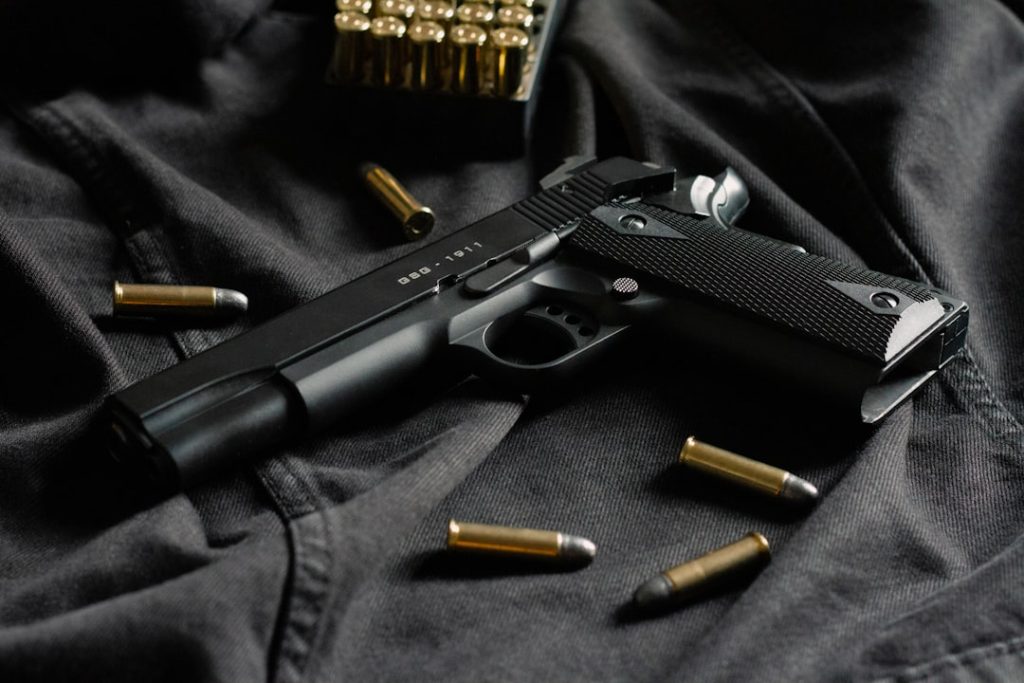Understanding firearm calibers and bullet types is crucial for anyone who owns or uses firearms. The caliber of a firearm refers to the internal diameter of the barrel, which determines the size of the ammunition it can fire. Bullet type, on the other hand, refers to the design and construction of the projectile that is fired from the firearm. By understanding these factors, gun owners can make informed decisions about which caliber and bullet type is best suited for their needs.

Understanding the Basics of Firearm Calibers and Bullet Types
Caliber is a term used to describe the internal diameter of a firearm’s barrel. It is typically measured in inches or millimeters. Common calibers include .22, 9mm, .45 ACP, .223 Remington, and .308 Winchester, among others. Each caliber has its own specific uses and characteristics.
Bullet type refers to the design and construction of the projectile that is fired from a firearm. There are several different types of bullets, including full metal jacket (FMJ), hollow point (HP), soft point (SP), and ballistic tip, among others. Each bullet type has its own unique characteristics and is designed for specific purposes and that is why discover more here.
Choosing the Right Caliber for Your Firearm: Factors to Consider
When choosing a caliber for your firearm, there are several factors to consider. First and foremost, you need to determine the purpose of the firearm. Are you using it for self-defense, target shooting, or hunting? Different calibers are better suited for different purposes.
Personal preferences and abilities also play a role in choosing the right caliber. Some people may prefer a smaller caliber for its reduced recoil and ease of use, while others may prefer a larger caliber for its stopping power. To learn more visit icbfirearms.
Availability and cost of ammunition is another important factor to consider. Some calibers may be more readily available and affordable than others, depending on your location and budget.
The Different Types of Bullets: Hollow Point, Full Metal Jacket, and More
There are several different types of bullets, each with its own advantages and disadvantages.
Full metal jacket (FMJ) bullets are commonly used for target shooting and military applications. They have a soft lead core surrounded by a harder metal shell, which helps to prevent deformation and ensure reliable feeding in semi-automatic firearms. However, FMJ bullets do not expand upon impact, which can limit their effectiveness for self-defense or hunting.
Hollow point (HP) bullets are designed to expand upon impact, creating a larger wound channel and transferring more energy to the target. This makes them highly effective for self-defense and hunting purposes. However, HP bullets may not penetrate as deeply as FMJ bullets, which can be a disadvantage in certain situations.
Soft point (SP) bullets have a partially exposed lead tip, which allows for controlled expansion upon impact. They are commonly used for hunting, as they provide a good balance between expansion and penetration. However, SP bullets may not expand as reliably as HP bullets.
Ballistic tip bullets have a plastic tip that enhances their aerodynamic properties and improves long-range accuracy. They are commonly used for hunting and long-range shooting. However, ballistic tip bullets may not provide as much expansion as HP or SP bullets.
How Bullet Weight Affects Performance and Accuracy
Bullet weight refers to the mass of the projectile that is fired from a firearm. It is typically measured in grains. The weight of a bullet can have a significant impact on its performance and accuracy.
In general, heavier bullets tend to have higher muzzle velocities and better long-range performance. They also tend to penetrate deeper into the target. However, heavier bullets may also produce more recoil and have a flatter trajectory.
Lighter bullets, on the other hand, tend to have lower muzzle velocities and may not penetrate as deeply into the target. However, they may produce less recoil and have a more arched trajectory, which can be advantageous for certain shooting situations.
The recommended bullet weight for a specific purpose will depend on factors such as the caliber of the firearm, the intended target, and the shooting distance.
The Impact of Barrel Length on Bullet Velocity and Accuracy
The length of a firearm’s barrel can have a significant impact on the velocity and accuracy of the bullets it fires. In general, longer barrels tend to produce higher muzzle velocities and better accuracy.
This is because the longer barrel allows for a longer period of time for the expanding gases behind the bullet to accelerate it down the barrel. This results in higher muzzle velocities and increased energy transfer to the target.
However, there is a point of diminishing returns when it comes to barrel length. Once a certain length is reached, the additional gains in velocity and accuracy become minimal. Additionally, longer barrels can be more cumbersome and less maneuverable, which can be a disadvantage in certain shooting situations.
The recommended barrel length for a specific caliber and purpose will depend on factors such as the type of shooting being done and personal preferences.
The Importance of Proper Ammunition Storage and Handling
Proper ammunition storage and handling is crucial for maintaining its performance and safety. Ammunition should be stored in a cool, dry place away from heat sources and moisture. It should also be kept in a secure location to prevent unauthorized access.
Ammunition should be handled with care to avoid damage to the cartridges or primers. Dropping or mishandling ammunition can cause it to become unsafe to use.
Improper storage and handling of ammunition can lead to malfunctions or accidents when firing. It is important to follow proper safety protocols and guidelines when storing and handling ammunition.
Recoil Management: Tips for Handling Powerful Calibers
Recoil refers to the backward movement of a firearm after firing a shot. It is caused by the force of the expanding gases pushing against the bullet and the firearm. Recoil can have a significant impact on shooting, particularly when using powerful calibers.
There are several techniques that can be used to manage recoil and improve shooting performance. These include proper grip and stance, using recoil pads or muzzle brakes, and practicing proper breathing and trigger control.
It is important to practice these techniques regularly to build muscle memory and improve recoil management skills. Additionally, using the appropriate caliber for your skill level and comfort level can help to minimize recoil and improve shooting accuracy.
The Advantages and Disadvantages of Popular Calibers: 9mm, .45 ACP, and More
There are several popular calibers that are commonly used for self-defense, target shooting, and hunting. Each caliber has its own advantages and disadvantages.
The 9mm caliber is one of the most popular choices for self-defense due to its manageable recoil, high magazine capacity, and availability of ammunition. It is also commonly used for target shooting. However, some people may prefer a larger caliber for its increased stopping power.
The .45 ACP caliber is known for its stopping power and effectiveness in self-defense situations. It has a larger bullet diameter than the 9mm, which can create larger wound channels and transfer more energy to the target. However, the .45 ACP typically has more recoil than the 9mm.
Other popular calibers include .40 S&W, .380 ACP, .223 Remington, and .308 Winchester, among others. Each caliber has its own specific uses and characteristics.
The Role of Bullet Expansion in Self-Defense and Hunting Situations
Bullet expansion refers to the expansion of a bullet upon impact with a target. This expansion creates a larger wound channel and transfers more energy to the target, increasing stopping power.
In self-defense situations, bullet expansion is crucial for quickly incapacitating an attacker and preventing further harm. Hollow point bullets are commonly used for self-defense due to their ability to reliably expand upon impact.
In hunting situations, bullet expansion is important for ensuring a clean and ethical kill. The type of bullet used will depend on the size and type of game being hunted. Hollow point, soft point, and ballistic tip bullets are commonly used for hunting.
Advanced Techniques for Mastering Firearm Calibers and Bullet Types
Mastering firearm calibers and bullet types requires practice and training. Here are some advanced techniques that can help improve accuracy and performance:
- Practice regularly with different calibers and bullet types to become familiar with their characteristics and performance.
- Experiment with different bullet weights to find the optimal weight for your firearm and shooting style.
- Work on developing proper grip, stance, and trigger control to improve recoil management and shooting accuracy.
- Seek out professional training or instruction to learn advanced shooting techniques and improve your skills.
- Stay up to date with the latest developments in firearm calibers and bullet types through continued education and research.
Understanding firearm calibers and bullet types is essential for anyone who owns or uses firearms. By understanding the basics of calibers and bullet types, gun owners can make informed decisions about which caliber and bullet type is best suited for their needs.
Factors such as the purpose of the firearm, personal preferences and abilities, availability and cost of ammunition, as well as the different types of bullets, bullet weight, barrel length, proper ammunition storage and handling, recoil management, advantages and disadvantages of popular calibers, the role of bullet expansion in self-defense and hunting situations, as well as advanced techniques for mastering firearm calibers and bullet types should all be considered when choosing the right caliber for your firearm.
Continued education and training in firearm calibers and bullet types is crucial for improving accuracy and performance. By staying informed and practicing regularly, gun owners can become more proficient and responsible in their use of firearms.
FAQs
What is a firearm caliber?
A firearm caliber refers to the diameter of the barrel of a gun. It is measured in inches or millimeters.
What are the most common firearm calibers?
The most common firearm calibers are .22, .38, .45, 9mm, and .223/5.56mm.
What is a bullet?
A bullet is the projectile that is fired from a firearm. It is typically made of lead or a lead alloy and is designed to be aerodynamic for accuracy and distance.
What are the different types of bullets?
There are several types of bullets, including full metal jacket (FMJ), hollow point (HP), soft point (SP), and ballistic tip (BT). Each type has its own unique characteristics and is designed for specific purposes.
What is a full metal jacket bullet?
A full metal jacket bullet is a type of bullet that has a metal casing that covers the entire bullet, except for the base. It is designed for target shooting and military use.
What is a hollow point bullet?
A hollow point bullet is a type of bullet that has a hollowed-out tip. When it hits a target, the tip expands, causing the bullet to mushroom and transfer more energy to the target. It is designed for self-defense and hunting.
What is a soft point bullet?
A soft point bullet is a type of bullet that has a partially exposed lead tip. When it hits a target, the tip expands, causing the bullet to mushroom and transfer more energy to the target. It is designed for hunting.
What is a ballistic tip bullet?
A ballistic tip bullet is a type of bullet that has a plastic tip that is designed to improve accuracy and reduce wind drift. It is designed for hunting and long-range shooting.

